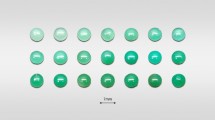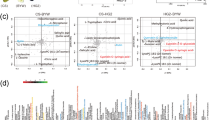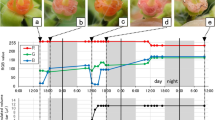Abstract
FLOWER colours, from red through purple to blue, are mostly from anthocyanins, a type of flavonoid1–5. Although there are many colours, only a few anthocyanidins, chromophores of the pigments, have been found. The colour of the pigments is stable in plants for a few days to one month but the extracted anthocyanins are, nevertheless, unstable and quickly lose colour by hydration in a neutral aqueous solution1–5. In 1915 Willstätter proposed that flower-colours vary because anthocyanins change their colour with the pH6. Shibata and Shibata questioned the theory because most plant cell sap was weakly acidic or neutral. Their alternative, based on metal-complex theory7 was refuted by Everest8. In 1958 Hayashi isolated in crystal form a blue pigment9, commelinin, a metal-complex anthocyanin (named metalloanthocyanin)10,11, from the blue petals of Commelina communis. But the existence of a blue-coloured magnesium complex was denied by Bayer et al.12. We obtained the same blue pigment as intact commelinin by reconstruction from its components13. We also prepared Cd-commelinin in which the complexation metal Mg2+ was replaced with Cd2+. We report here the X-ray crystal structure of a real anthocyanin and a sugar-containing flavonoid, using Cd–commelinin. The blue flower-colour development and the stability of the colour can be explained by metal complexation of antho-cyanin and intermolecular hydrophobic association.
This is a preview of subscription content, access via your institution
Access options
Subscribe to this journal
Receive 51 print issues and online access
$199.00 per year
only $3.90 per issue
Buy this article
- Purchase on Springer Link
- Instant access to full article PDF
Prices may be subject to local taxes which are calculated during checkout
Similar content being viewed by others
References
Goto, T. & Kondo, T. Angew. Chem. Int. Edn Engl. 30, 17–33 (1991).
Harborne, J. B. & Grayer, R. J. in The Flavonoids, Advances in Research since 1980 (ed. J. B. Harborne) 1–20 (Chapman and Hall, London, 1988).
Brouillard, R. in The Flavonoids, Advances in Research since 1980 (ed. J. B. Harborne) 525–538 (Chapman and Hall, London, 1988).
Goto, T. Prog. Chem. nat. Prod. 52, 113–158 (1987).
Brouillard, R. in Anthocyanins as Food Colors (ed. P. Markakis) 1–40 (Academic Press, New York, 1982).
Willstätter, R. & Mallison, H. Justus Liebigs Annln Chem. 408, 147–162 (1915).
Shibata, K., Shibata, Y. & Kashiwagi, I. J. Am. chem. Soc. 41, 208–220 (1919).
Everest, A. E. & Hall, A. J. Proc. R. Soc. B92, 150–162 (1921).
Hayashi, K., Abe, Y. & Mitsui, S. Proc. Japan Acad. 34, 373–378 (1958).
Mitsui, S., Hayashi, K. & Hattori, S. Proc. Japan Acad. 35, 169–174 (1959).
Hayashi, K. & Takeda, K. Proc. Japan Acad. 46, 535–540 (1970).
Bayer, E., Egeter, H., Fink, A., Nether, K. & Wegmann, K. Angew. Chem. Int. Edn Engl. 5, 791–798 (1966).
Tamura, H., Kondo, T. & Goto, T. Tetrahedron Lett. 27, 1801–1804 (1986).
Goto, T., Kondo, T., Tamura, H. & Takase, S. Tetrahedron Lett. 24, 4863–4866 (1983).
Hayashi, K. & Takeda, K. Proc. Japan Acad. B53, 1–5 (1977).
Takeda, K. Proc. Japan Acad. B53, 257–261 (1977).
Hoshino, T., Matsumoto, U. & Goto, T. Phytochemistry 20, 1971–1976 (1981).
Hoshino, T., Matsumoto, U., Harada, N. & Goto, T. Tetrahedron Lett. 22, 3621–3624 (1981).
Sheldrick, G. M. Acta Crystallogr. A46, 467–473 (1990).
Goto, T., Yoshida, K., Yoshikane, M. & Kondo, T. Tetrahedron Lett. 31, 713–716 (1990).
Asen, S., Stewart, R. N. & Norris, K. H. Phytochemistry 11, 1139–1144 (1972).
Robinson, G. M. & Robinson, R. Biochem. J. 25, 1687–1705 (1931).
Kondo, T., Yoshida, K., Yoshikane, M. & Goto, T. Agric. Biol. Chem. 55, 2919–2921 (1991).
Kondo, T., Tamura, H., Yoshida, K. & Goto, T. Agric. Biol. Chem. 53, 797–800 (1989).
Kondo, T., Yoshikane, M., Yoshida, K. & Goto, T. Tetrahedron Lett. 30, 6729–6732 (1989).
Tamura, H., Kondo, T., Kato, Y. & Goto, T. Tetrahedron Lett. 24, 5749–5752 (1983).
Sakabe, N. Nucl. Instrum. Meth. A303, 448–463 (1991).
Higashi, T. J. appl. Crystallogr. 22, 9–18 (1988).
Hall, S. R. & Stewart, J. M. (eds) Xtal3.0 Reference Manual (Univ. Western Australia and Maryland, 1990)
Author information
Authors and Affiliations
Rights and permissions
About this article
Cite this article
Hondo, T., Yoshida, K., Nakagawa, A. et al. Structural basis of blue-colour development in flower petals from Commelina communis. Nature 358, 515–518 (1992). https://doi.org/10.1038/358515a0
Received:
Accepted:
Issue Date:
DOI: https://doi.org/10.1038/358515a0
This article is cited by
-
Assessment of early physiological and biochemical responses in chia (Salvia hispanica L.) sprouts under salt stress
Acta Physiologiae Plantarum (2021)
-
For antagonists and mutualists: the paradox of insect toxic secondary metabolites in nectar and pollen
Phytochemistry Reviews (2020)
-
Arabidopsis molybdenum cofactor sulfurase ABA3 contributes to anthocyanin accumulation and oxidative stress tolerance in ABA-dependent and independent ways
Scientific Reports (2018)
-
Disorder in convergent floral nanostructures enhances signalling to bees
Nature (2017)
-
Quantification of light screening by anthocyanins in leaves of Berberis thunbergii
Planta (2017)
Comments
By submitting a comment you agree to abide by our Terms and Community Guidelines. If you find something abusive or that does not comply with our terms or guidelines please flag it as inappropriate.



